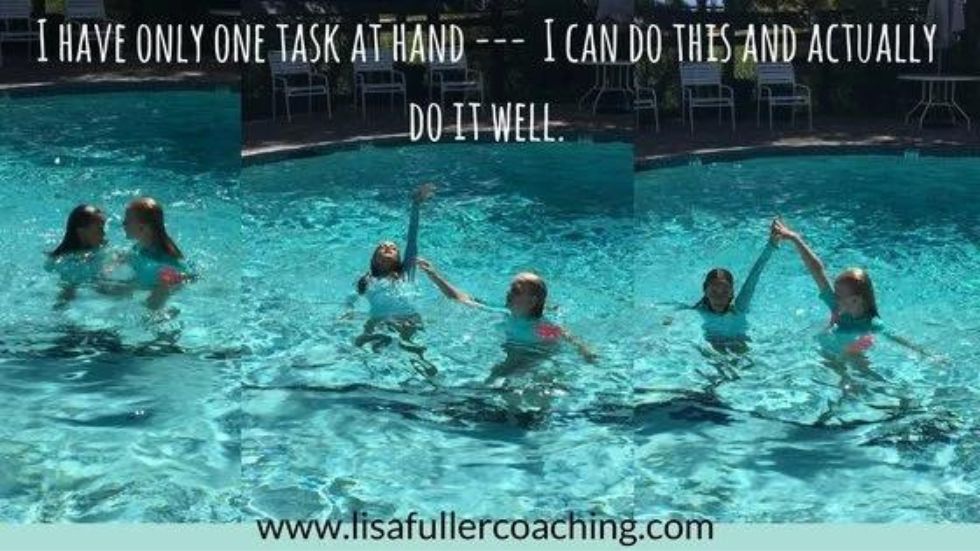
by Lisa Fuller | Sep 14, 2017 | Communication, Encouragement, General, Parenting
Remember that day last summer when I took the girls to the pool and I decided to get out of the middle of the parenting road (because heck it’s dangerous standing there!)?
Here’s the scene: I’ve got two 9 year old girls, my daughter Sonja and her friend Gracie. These girls are avid swimmers, eager to get to the pool to play. I fantasize that our trip will include my making serious headway with my summer reading (even tho it’s September), while they amuse themselves.
As it is with parenting, my expectation of time for myself proves a pipe dream as they repeatedly ask me to watch their antics in the water.
I decide to go all in and be present with the girls. I see them with their faces all lit up and full of life because they can tell — I’m all in.
What does being present with them look like?
Their request for attention begins simply.
For the first ten minutes its,
“Mom, tell us who has the biggest splash when we jump in!”
This is easy.
For the next five minutes,
“Mom, now who’s got the smallest splash?”
Next the requests get more complicated.
“We’re going to each make up a dance and you tell us which one is better. We won’t care which one you choose… PLEEEEEEEEASE.”
What kind of attention do I give the girls?
These are the two choices I imagine:
- The fluffernutter with jelly beans sandwich! Equalize the good stuff – like an overdose on sweets. I’ll go back and forth stating whose performance is best.
Wonderful, beautiful. Oh such great moves. I’ll continue with loads of oooohing and Ahhhing. Wow’s coming flying out of my mouth and a resounding you girls are amazing!
Hyperboles abound aimed at both girls, alternating names. They’ll each feel the rush of being the BEST!
- I take a moment to process this request and then say to the girls,
No, that kind of judging is what we call ‘subjective’ — which means just one person’s opinion — and that’s going to be too hard for me.
“Please mom, I promise we won’t care which one you pick.”
No sweetie.
As a result, the girls decide to create individual dances and ask me to watch them after a few moments of practice.
I support them by being present.
In this scenario I’ve decided to simply pay attention to them. I have the presence of mind to respond genuinely to their beautiful 9 year old bodies moving with the raw vitality.
I smile.
I make eye contact.
I smile.
My response doesn’t sound or even look like much. I feel mellow… down right relaxed even and heck I’m enjoying myself 🙂
I notice that when my daughter pops out of the water, during a particular dance move, her eyes are fixed on my eyes – am I looking at her?
She smiles and I smile back. A simple genuine and powerful encouragement connection.
The girls are laughing and having a ball.
They’re being graceful and silly at the same time; authentically creative.
I love being their audience and simply encourage them by noticing, laughing, hooting, oooohing.
My comments sound like,
“Looks like you’re learning moves from each other.”
“Did that hurt?”
“Fun!”
I bite my tongue to keep from spouting judgments (albeit positive) and opinions.
After years of teaching parenting classes, I still find biting my tongue to be one of my greatest parenting tools :).
While the automatic over the top enthusiastic responses feel like the way to be a supportive parent, they aren’t.
Carol Dweek’s work on praise vs. effort vs. intelligence is explained in this short video.
Simply paying attention is down right relaxing for me and I can see it’s freeing for the girls as I watch them become more goofy, beautiful and collaborative with every new dance.
They’re not dancing to please me, but to please themselves.
During the next hour I have a singular, delightful focus. Even now, a year later, it’s a rich memory for me. I can still see the girls’ lit faces, their determination, their playfulness.
Deciding to pay attention without praising is powerful and allows your child to be playful— to be themselves.
Look for opportunities to be with your children — to pay attention to them without fanfare but with your full, genuine awareness. See what you notice in yourself and your kids. And then come back and share your experiences in the comments.
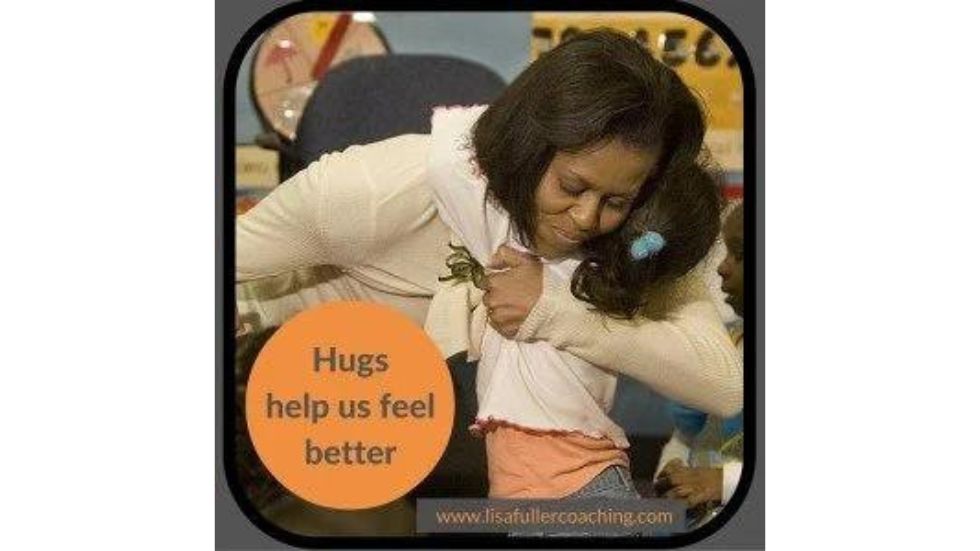
by Lisa Fuller | Mar 26, 2016 | Communication, Connection & Love, Encouragement, General, Parenting, Self-regulation
Shortly after Eric finished up my 7- week parenting series, he sent me this story which beautifully illustrates the power of asking for a hug.
Last week on my way home from work, my wife Stephanie sent me a text that our daughter Grace (5) was being a handful, was in a horrible mood and that she had had it with her.
When I got home, I walked into the house and went straight to Grace and asked her for a hug. At first she turned her back and crossed her arms, and said no.
I then decided to ask her one more time and after a 5-second pause, she turned and gave me a big hug.
Steph said it was like someone flipped a switch on Grace. She went from being in the worst mood to acting as if she was having the best day ever.
It’s amazing to see the kind of impact and dynamics that something as simple as asking for a hug can have on a 5 year old.
Honestly, before taking your class, I probably would have come home and punished Grace for misbehaving and the entire afternoon would have been ruined for the whole family.
Asking for a hug sounds almost too easy, right? Too simple to be true?
However, while it’s simple… there’s a subtle tweak that’s key to the effectiveness of this parenting strategy.
“I could use a hug” vs. “Can I give YOU a hug?”
The first taps into your child’s deep need for significance and belonging. When you ask for a hug from your child, you acknowledge that they make a difference to you and in fact have a positive influence on your life.
In the later, you are reinforcing what your child hears and perhaps feels frequently: That children need help from grownups to feel better.
The parenting tool of asking for a hug (for YOU) is simple, easy, and effective if done from the perspective of genuine connection, genuine desire for your child to assist you! (Plus, who doesn’t love hugs? I love it!)
Try it out.
Ask a friend to be your parent and say these two phrases to you:
Could you give me a hug?
and
You look like you could use a hug.
Do you notice a difference in how you feel after each?
This week look for an opportunity to ask your child for a hug.
I’d love to hear how it goes in the comments below!
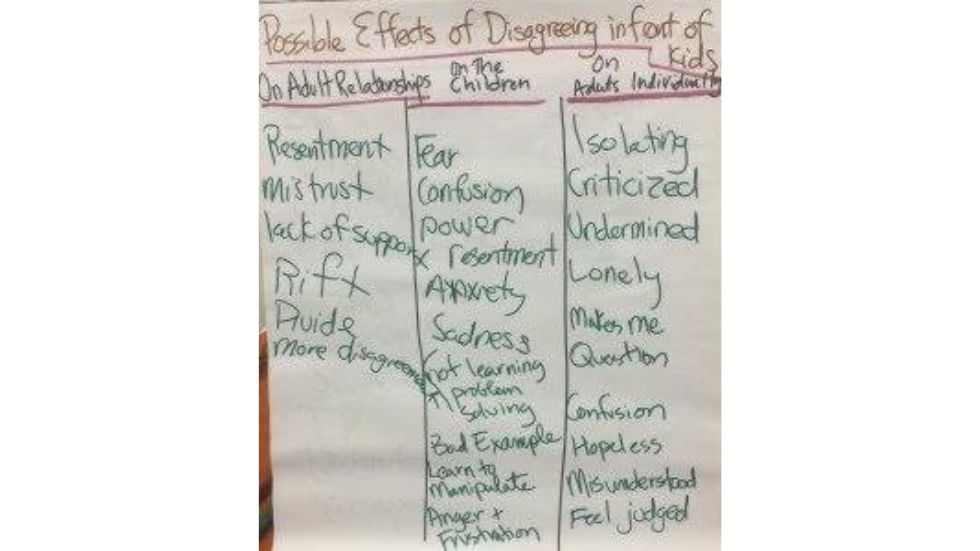
by Lisa Fuller | Feb 24, 2016 | Communication, Conflict, General
 As much as we wish it weren’t true, our relationship with our parenting partner, how we communicate, how we make decisions and how we parent… is closely observed by our children.
As much as we wish it weren’t true, our relationship with our parenting partner, how we communicate, how we make decisions and how we parent… is closely observed by our children.
Of course we are not going to have a perfect partnership but there are ways we can increase the odds of providing a healthy model.
Below is a list of resources to explore to learn more on this topic including tips on how to come closer together in parenting styles and how to best manage conflict in your co-parenting marriage.
Ideas For How to Deal with the Dreaded Style Clash
When You Don’t Discipline the Same Way from Power to Change.com.
Best Practices for How to “Fight” When You’ve Got Kids
12 Keys To Healthy Partnership Conflict Resolution When you Live With Kids from Aha Parenting.
Parent Arguments: How Do They Effect Children? from Bright Horizons Family Solutions.
Family meetings are a wonderful resource to help find solutions to all sorts of issues that families experience. They also provide a forum for parent to model working out challenges in a positive, open, solutions oriented manner. Here is a guide that I created to help make family meetings EASY.
Having a regular “parenting pow-wow” can also be extremely helpful: setting aside some time each week or month to make agreements on how to handle various parenting challenges, and what you will do when you not not agree on a course of action.
In our recent Roots session we explored the following questions:
- What are the possible effects of disagreeing in front of the kids on the adult relationship, children and on the individual adult?
- What are typical topics that parents and caregivers disagree over?
- What are respectful alternatives when parents disagree?
- What are the possible effects of these alternatives on the adult relationship, children and on the individual adult?

Possible Effects of Disagreeing in Front of Kids

Typical Topics For Parent/Caregiver Disagreements

Respectful Alternatives When Parents/Caregivers Disagree

Possible Effects of Respectful Alternatives
In these last two posters we looked at how parents with different styles, specifically one who is “more Positive Discipline” leaning and one who is less, might support each other best. We came up with DO’s and DON’T’s for each person.

The More Positive Discipline Parent is encourage to:

The Less Positive Discipline Parents who like the More Parent to:
This topic is alive on this seemingly static page! Please use the comment section to add your thoughts and additional resources to share on this important of how parents with different parenting styles can be successful.
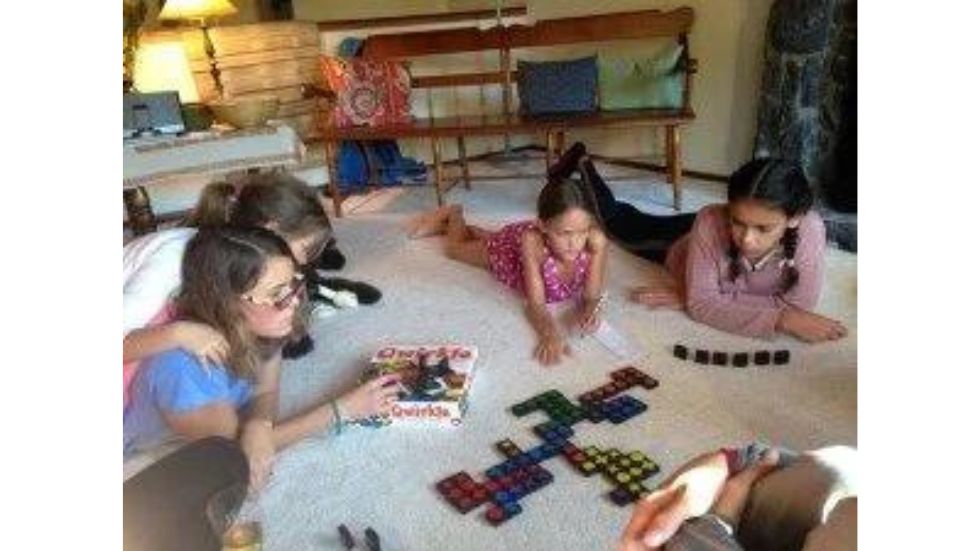
by Lisa Fuller | Dec 10, 2015 | Communication, Connection & Love, Feelings & Emotions, General, Parenting
If you’re like me, you’re struggling right now to wrap your head around all that’s been going on in the world.
I don’t pretend to have the answers, but from my perspective it seems like disconnection is at the root of so much of the insanity and violence.
I believe that deepening and strengthening our connections — to each other, to the planet, to our families — is our path to healing.
It might seem simplistic, but I’m convinced that our collective well being and health begins with the health of our families.
And where better to start than with the holidays?
We all crave warm, loving connections with our family and children, this time of year more than ever. Bring on the dark storm so that we can be snug together, play a game, listen to music, and share a meal.
And while there may be heated moments of competition or disagreement, it’s all good because we’re together, making time for each other.
The following gift ideas may help you with this goal.
The list is organized into four categories:
- Tools
- Practices
- Games
- Books

Tools
- Dinner Bell. This is so simple yet almost daily I’m reminded of the power of our dinner bell. Whether I make breakfast, a snack, lunch on the weekends, or dinner, I often notice a wee bit of tension building when my child isn’t eagerly awaiting my labor of love. Then I see the bell and it dawns on me: “Just ring the bell.” I can feel my expectations melting away with that simple action. Message delivered. I can breath and move on.
- Mobilhome. Our devices get in the way of real connection. The
Mobilhome is a super cool way to — without making a stink — let your friends and family know that when socializing in your home, you encourage a device free zone. By establishing a place for everyone’s phones, you’re acknowledging the value of spending undistracted time together. The Mobilhome is an original artisan project created by Yvonne O’Hare (we met at a writing workshop). When ordering one, use the code “holiday2015” until December 15 for an extra 10% discount with free shipping. If it’s out of your price range simply find a basket for phones to call home.

- Positive Discipline Tool Cards. I gift these to parents who
enroll in my Parenting with Positive Discipline series. They are concise and powerful. Topics include: allowance, letting go, setting limits, kindness and firmness at the same time, silent signal and 47 more! Great for when you need a focused idea on one particular challenge.
Practices
- “Passing the Squeeze,” a ritual shared by my friend Catherine, will help you slow down and mindfully connect before meal time. You begin each family lunch or dinner with “passing the squeeze.” Everyone holds hands (people may choose to close their eyes if they wish). The person who cooked starts a hand squeeze in one direction and it gets passed around. When the squeeze gets back to the person who started it, she squeezes hands in both directions and then everyone squeezes hands. For extra credit meditation kudos, the person who cooked rings a meditation chime. Everyone listens for as long as possible before picking up cutlery and chowing down (I’ll let you know how that goes over at our house:).
- Family Meetings… Why have family meetings? They
- Build closeness by creating a sense of significance and belonging for all.
- Give children and their parents a place and time to practice leadership, responsibility, problem solving, empathy and love.
- Establish a forum for communication that becomes increasingly significant as children mature.

Once you begin to hold family meetings you’ll experience even more tangible and intangible benefits for your family!
Join my list to download: Unlock the Power of Family Meetings: Your Free 7-Step Guide.
Games
- Qwirkle. I love this game! Using six unique colors and shapes your mind is challenged to find configurations that conform to the rules (no repeating) and give you the most points. It takes 30 – 60 minutes to play depending on how much conversation and silliness you enjoy. Recommended for ages 6 and up.

- Sorry. Be sure to get the original version. What can I say? This is simple and fun. My son warned me against recommending Sorry because he said it gets people too riled up 🙂 That said, it’s most fun when everyone gets invested, regardless if you’re 7 or 70! It’s equal parts skill and luck… maybe more luck. Old school fun!
- Hunt the Thimble. My friend Anna loves to play this one on Sunday evenings after their family dinner at her mother in-law’s house. Try it when you’ve got friends over or with the extended family. All ages! Here’re the steps to play:
- Find a thimble
- Choose someone to be “it”
- Tell that person to leave the room
- Choose another person to be the hider
- Call in the seeker to start looking (it should be hidden within eyesight, not under or in anything)
- The whole group can yell out “colder!”…”warmer…” Until the thimble is discovered.
- Let the last hider now become the seeker, and so forth until someone rings the dinner bell 😉
Side note to parents of teens… it’s more important than ever to make the time to play games and simply find ways to be together. Don’t rely on your kids to come to you and ask for this time — if they do, consider yourself lucky! When your teen resists family time, I suggest persistence. Let them know that being with them is important to you. Here are general tips from Aha! Parenting for keeping connected to your teen.
Books
My grandfather used to read stories aloud and even when I was too young to understand the content, I have warm memories of sitting on the floor next to him as he read while the entire family listened. The tone of his voice and response of those listening was enough for me. Here are some of my favorites to read to my children.
- The Tale of Custard the Dragon by Ogden Nash. So
 fun and lyrical! Enjoyable for every age! Here’s a taste:
fun and lyrical! Enjoyable for every age! Here’s a taste:
Belinda lived in a little white house, with a little black kitten and a little gray mouse, and a little yellow dog and a little red wagon, and a realio, trulio little pet dragon…. Custard the dragon had big sharp teeth, and spikes on top of him and scales underneath, mouth like a fireplace, chimney for a nose, and realio, trulio daggers on his toes.
- Sarah’s Unicorn by Bruce Coville. While this is great for early readers, I read it over and over to my children when they were 4 to 8 years old. We’re talking pages falling out. It was the hands down favorite for my son who struggled most with reading and finding interest in books. It’s out of print but you can find it used.
- Charlotte’s Web, Stuart Little, and Trumpet and the Swan by E.B. White. What I love about E.B. White is his spaciousness – these stories are told at a human pace and scale. And what could be better than a mouse and a pig for main characters. The Trumpet and the Swan was harder for my daughter to relate to… maybe because she’d been immersed in the Harry Potter series and the change of pace was too dramatic? For ages 6+.

- The Gifts of Imperfection: Let Go of Who You Think You’re Supposed to Be and Embrace Who You Are by Brené Brown. This one is for YOU to bolster your connection with yourself!! I come back to this book again and again as I find its message
 continually challenging and interesting. There are 10 guideposts for living our most excellent imperfect life. Take this a step further by gathering your most curious friends, and meet monthly to explore each guidepost.
continually challenging and interesting. There are 10 guideposts for living our most excellent imperfect life. Take this a step further by gathering your most curious friends, and meet monthly to explore each guidepost.
Cultivate those activities that feed your connection to self and others.
Relax and be present. That’s what your kids want from you more than anything.
To increase the likelihood that you can relax and slow down, focus on  activities like these:
activities like these:
- Take a bath
- Exercise, take walks
- Cook or take out foods that make you feel good
- Make time to read a good book
- Go to bed early
- Do something creative
In general, try to keep it simple, focus on the inside, notice the hilarity
and joy of spending time with kids… generally BE KIND TO YOURSELF. That’s it.

by Lisa Fuller | Oct 30, 2015 | Communication, General, Parenting
Guest post by Marcilie Smith Boyle
The topic of lying came up in my parenting class last week. We were role-playing parents’ typical responses to a lying kid:
“Honey, did you just lie about that? Are you sure?” (When parent already knows the child is lying)
“Are you kidding me? You just lied straight to my face. How COULD you?”
“That’s it, no more (fill in the blank__________) for you!”
Everyone agreed that the typical responses above didn’t help the child learn to be honest, but they also wondered what the heck else to do!
Strangely, the very next night at bedtime, my own teen looked my husband straight in the eye and said he didn’t have his phone in his room (which is not allowed in our house.)
We scanned the downstairs charging area where the phones are supposed to “sleep” at night, and didn’t see the phone there. Or anywhere else. So I went back upstairs and knocked on my son’s door. He opened it and handed me his phone.
I had a really important conversation that I needed to finish and I knew that Dad would not let me finish it. I’m done now so here you go, he said.
I replied, You know, if you had explained that to Dad, maybe he would have let you finish your conversation.
No chance, my son replied.
Well, I said, you didn’t give him a chance. He might have. And even if he didn’t, was the lie worth the loss of trust and relationship?
Good night, Mom. Apparently, it was.
Good Night, C. We can talk more about this in the morning. I love you.
It’s an interesting question for parents to ponder: sometimes, to the child, the lie is worth the loss of trust and relationship. And sometimes, the lie is protecting trust and relationship (in their mind, anyway, because “If Mom found out that I actually did steal that candy bar, she would lose her trust in me and our relationship would suffer.”)
So what to do? How do we help our children to become honest, trustworthy, and develop integrity for doing the right thing?
“We may treasure honesty, but the research is clear. Most classic strategies to promote truthfulness just encourage kids to be better liars.” Po Bronson, Nurtureshock
Here are a few tips gathered from various experts on the subject.
-
Just know that all kids lie. Home observation studies found that “four-year-olds will lie once every two hours, while a six-year-old will lie about once every hour . . . 96% of all kids offer up lies.” (Nurtureshock by Po Bronson) I used to feel completely betrayed when I discovered that my child lied to me. Now, I am less personally appalled, which means I can respond with less emotion, and increase the odds of productive learning in the aftermath.
-
Avoid punishment. When children first begin lying, they do so to avoid punishment. The threat of punishment puts the child’s focus on self-preservation, rather than on the bigger issue of doing the right thing. “In studies, scholars find that kids who live in threat of consistent punishment don’t lie less. Instead, they become better liars, at an earlier age – learning to get caught less often.” (Nurturshock)
-
Don’t trap your child in their lie. If you know your child has lied, don’t ask them if they have, which is an invitation to dig themselves even deeper into the lie. Instead of “Have you washed your hands?” when you know they haven’t, describe what you see: “I see dry hands,” and invite the next step: “would you like some help washing those germs away?” (Dr. Laura Markham, AhaParenting.com)
-
When your child has lied to you, be honest yourself. Jane Nelsen and Lynn Lott of Positive Discipline recommend you say, “That doesn’t sound like the truth to me. Most of us don’t tell the truth when we are feeling trapped, scared, or threatened in some way. I wonder how I might be making you feel that it isn’t safe to tell the truth? Why don’t we take some time off right now? Later I’ll be available if you would like to share with me what is going on for you.”
-
Reward honesty with immunity and appreciation. This advice comes from Dr. Victoria Talwar, one of the world’s leading experts on children’s lying behavior. If you want the truth from your child, teach them the worth of honesty by telling the child, “If you are honest with me, I promise that I will not punish you and in fact, I will appreciate you even more for telling the truth.” Her research shows that offering immunity PLUS praise for honesty reduces lying by between 50-75%.
-
Deal with the actual problem. Lying about having hit one’s brother is a problem, but the real problem is feeling the need to hit in the first place. So put the focus on the hitting and look for solutions to that problem, rather than on the lying. (Positive Discipline A-Z)
-
Be aware of what you are modeling. Turns out, adults lie too, at a rate of about one per day, on average. (Nurtureshock) The vast majority of these are little white lies to avoid hurting feelings, protect ourselves from looking bad, or avoid engaging in something we’d rather not. When a telemarketer calls and asks if you are home, do you ever say, “I’m sorry, she’s not here right now”? Our kids are listening!
As for my own situation with my teen, the next day I told him, “Dad and I really value trust. And we also recognize that you feel might feel trapped – you both want our trust and you want to be connected to your friends as school, especially when there’s a lot going on around Homecoming and homework and the PSAT. We understand that. We try hard to be reasonable people and when you’re feeling pressure to conceal the truth from us, we hope that you will let us know so that we can look for a win/win.”
Will he lie less in the future? I don’t know. I can’t make him be honest. All I can do is my best to create an environment and a relationship that makes honesty easier. And model it myself, of course.
I’ve decided to notice how often I lie today. Already caught one! (I can’t believe it! Dang!) More results later. ( ;
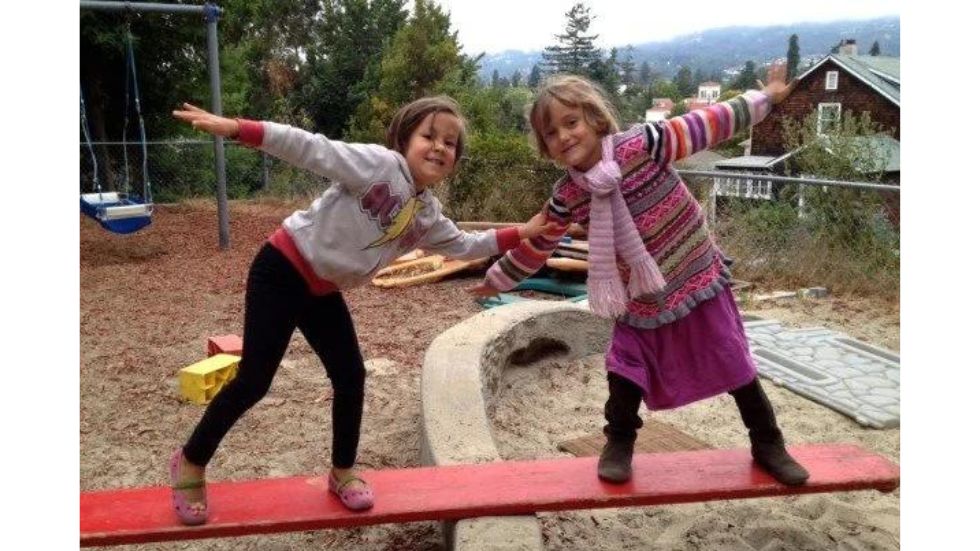
by Lisa Fuller | May 12, 2015 | Communication, Encouragement, Feelings & Emotions, General, Parenting, Sibling Issues

Practice Scripts for Parents: So you can stop unwittingly contributing to your children’s fighting
In Part One we looked at the tremendous learning that results from sibling relationships.
In Part Two we looked at the importance of staying out of your kids’ fights after establishing — and repeatedly reminding kids of — family rules and expectations. (Here’s the index with all of the resources.)
Here in Part Three we’ll explore what you do, unintentionally, to increase sibling acrimony and what you can specifically, say or do instead.
Imagine …
Scenario 1: You’re at a work meeting with your colleague (Joe) and your boss (Big Cheese). You and Joe present what you’ve been working on for the last month at which time Big Cheese looks Joe in the eye and says, “Joe what you’ve done here is outstanding work— you’re exceptional, you really are.”
Be with that. What runs through your mind, your heart?
Scenario 2: You come home after what’s been a bad day and share with your spouse what happened at work, “I just finished this huge project. Joe and I presented it to the Big Cheese, and well, you had to be there, but I felt really unappreciated. It made me feel like crap actually. I put so much of myself into that project, but he didn’t recognize me at all.”
Then your spouse replies, “You know you make a difference — the work couldn’t have been done without you. You need to remember you’re good enough whether someone tells you or not.”
Be with that. What runs through your mind, your heart?
While these are adult scenarios, what they illustrate are common mistakes we make with our children. Sometimes, daily.
The first scenario highlights the perils of praise — the non-specific superlative — and how the use of praise is particularly detrimental to the sibling bond.
How did you feel when you imagined yourself in the scenario?
In parenting class we role-play a parent praising one child but not the other. The volunteer playing the sibling not receiving praise — without exception — feels badly about themselves and usually resentful of their praise worthy sibling.
The un-praised sibling goes on to assume that the accolades lavished on sister or brother mean they’re destined to fall short… big time. Right or wrong this is a predictable human response.
In scenario 2, I’ve put the spotlight on how the denial of feelings, while well intentioned (like praise), is in fact discouraging because it communicates that we’re wrong when what we crave is to feel understood.
Below are four parent behaviors that hurt sibling relationships, followed specific examples of what they sound like and what you could say instead.
PRAISE ➜ ENCOURAGE
- Wow — you’re the fastest swimmer out there! ➜ I love to watch you swim!
- You’re such a good boy! ➜ I appreciate your help, you made my day easier.
- With more work, you’ll get it right. ➜ Look how far you’ve come, you can do it.
DENY FEELINGS ➜ ACKNOWLEDGE FEELINGS
- Just get along — she’s your sister! ➜ It sounds like you’re feeling really sad and hurt.
- Don’t say you hate your brother — that’s not nice. ➜ It looks like you guys aren’t getting along right now and could use some time away from each other.
COMPARISON ➜ DESCRIBE BEHAVIOR (put kids in the same boat)
- Why can’t you just be nice like your sister!? ➜ I can see you’re really cranky right now… come find me when you decide you’re ready to talk.
- Why do you always make things so difficult? ➜ Kids, I have faith that the two of you can work this out together. Come find me if you need help.
LABEL ➜ DESCRIBE WHAT YOU SEE, FEEL OR THE PROBLEM
- You’re the family artist. ➜ You really love to create!
- Why are you always such a bully? ➜ I see that the blocks are all over the floor, what can you do to help the situation?
- I can’t take it — you’re such a slob! ➜ Milk is all over the floor — what do you need to clean it up?
When spelled out like this, it’s crystal clear to me that [tweetthis] conscious parenting is a practice, not the default for any of us.[/tweetthis]
So it’s time to practice!
I know how hard it is so I created this Script to make it a bit easier.
Download it — print the pages you find helpful and PRACTICE.
Share your insights, questions and feedback below or write to me privately. I’d love to hear from you.



















 continually challenging and interesting. There are 10 guideposts for living our most excellent imperfect life. Take this a step further by gathering your most curious friends, and meet monthly to explore each guidepost.
continually challenging and interesting. There are 10 guideposts for living our most excellent imperfect life. Take this a step further by gathering your most curious friends, and meet monthly to explore each guidepost.




